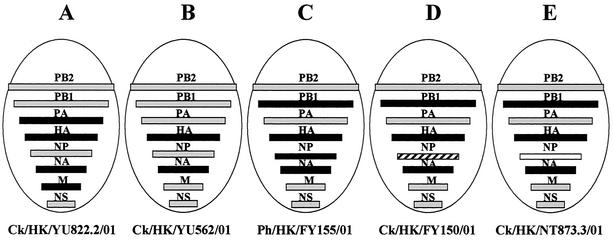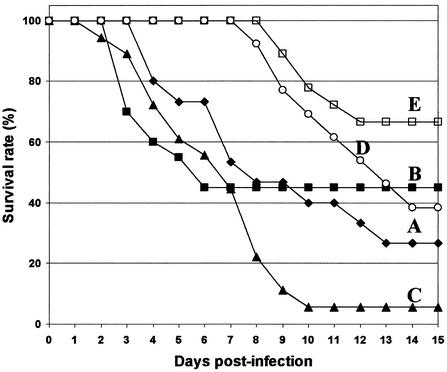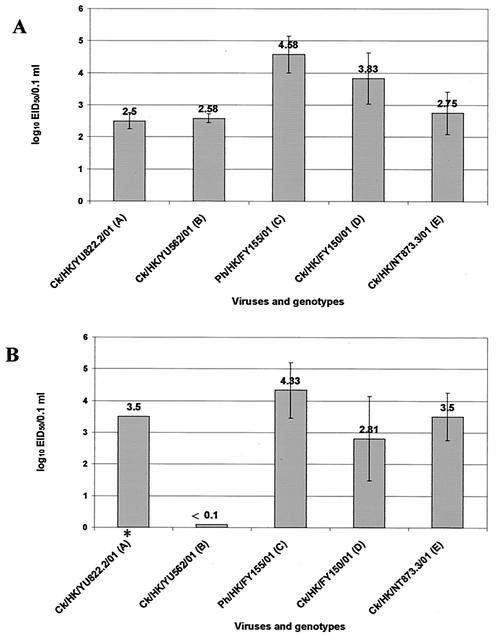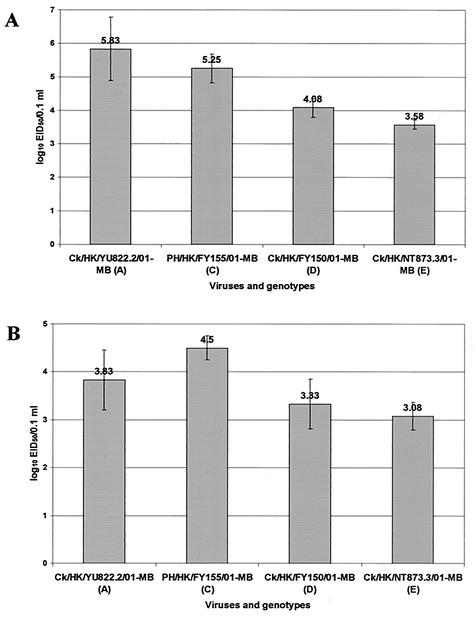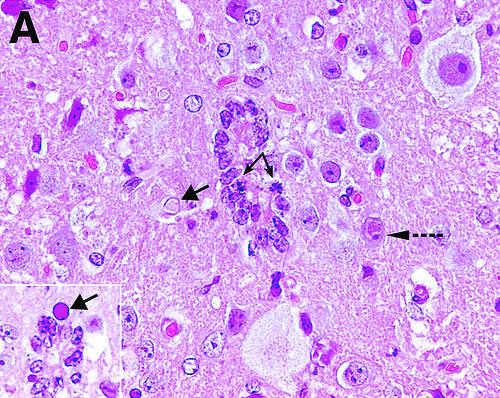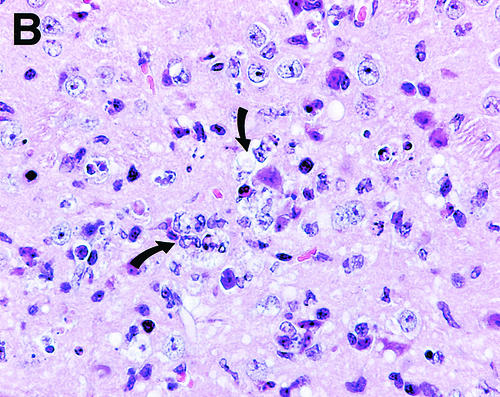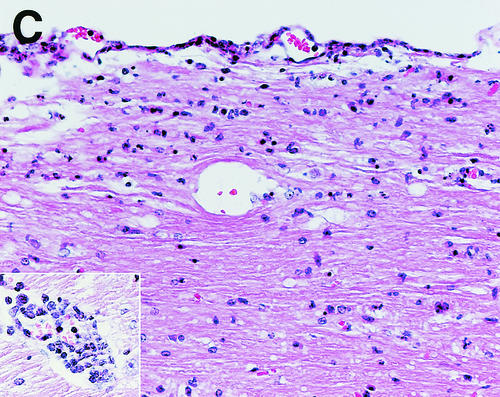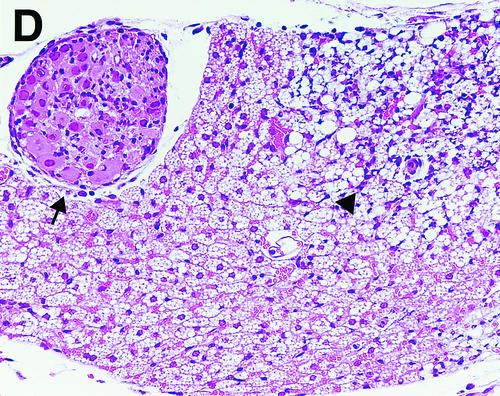Abstract
We studied the pathogenicity of five different genotypes (A to E) of highly pathogenic avian H5N1 viruses, which contained HA genes similar to those of the H5N1 virus A/goose/Guangdong/1/96 and five different combinations of “internal” genes, in a mouse model. Highly pathogenic, neurotropic variants of genotypes A, C, D, and E were isolated from the brain after a single intranasal passage in mice. Genotype B virus was isolated from lungs only. The mouse brain variants had amino acid changes in all gene products except PB1, NP, and NS1 proteins but no common sets of mutations. We conclude that the original H5N1/01 isolates of genotypes A, C, D, and E were heterogeneous and that highly pathogenic neurotropic variants can be rapidly selected in mice.
The outbreak of avian influenza A virus of subtype H5N1 in Hong Kong in 1997 killed 6 of 18 infected persons (4, 5, 35) and was the first documented case of direct transmission of avian influenza virus from poultry to humans. The outbreak led to the development of serious lethal diseases and was regarded by some as an incipient pandemic situation (27). The slaughter of all poultry in live poultry markets in Hong Kong in December 1997 removed the source of infection and prevented further transmission to humans (28). The human H5N1 isolates (H5N1/97) are thought to be naturally occurring reassortants of the avian virus in which the hemagglutinin (HA) gene is highly homologous to that of A/goose/Guangdong/1/96 (H5N1) (Go/Gd) (30, 34) and the replicative complex is highly homologous to that of A/quail/Hong Kong/G1/97 (H9N2) and A/teal/Hong Kong/W312/97 (H6N1) viruses (8, 15). The neuraminidase (NA) gene of H5N1/97 viruses is also closely related to that of A/teal/Hong Kong/W312/97 (15).
During 1999 and 2000, the Go/Gd-like H5N1 viruses continued to circulate in geese in Southeastern China (3, 9, 33). These viruses have reassorted with viruses of aquatic avian origin, and multiple genotypes of highly pathogenic H5N1 viruses containing HA and NA genes from Go/Gd-like viruses reappeared in land-based poultry in the markets in Hong Kong between February and May 2001. This reappearance of H5N1 viruses in terrestrial poultry—the first to occur after the outbreak in December 1997—resulted in the second slaughter in 4 years of all live poultry in Hong Kong's Special Administrative Region (10, 33). All of the H5N1 viruses isolated from poultry in the retail markets during winter and spring 2001 were reassortants that contained HA and NA genes of Go/Gd lineage and “internal genes” of other aquatic avian viruses (10). Five types of reassortants, with genotypes designated A, B, C, D, and E, were observed and grouped according to the phylogenetic origins and constellation of the “internal” genes (Fig. 1). Viruses of all five genotypes are highly pathogenic for chickens and quail; all five genotypes are also lethal to mice inoculated with a high dose of infective virus. Moreover, viruses of four of the five genotypes have been isolated from the brains of mice that had signs of central nervous system (CNS) disorders (10).
FIG. 1.
Genotypes of Hong Kong 2001 H5N1 viruses. Initial genotyping of H5N1/01 viruses on the basis of partial gene sequences (10) was confirmed in the present study by determination of the full-length sequences. The solid bars indicate genes of A/goose/Guangdong/1/96-like lineage, the hatched bars indicate genes of A/duck/HK/Y280/97-like lineage, the shaded bars indicate genes of wild aquatic bird lineage, and the open bars represent genes of unknown lineage.
Influenza A virus pathogenicity in mice usually requires adaptation to the new host, which occurs during growth of several consecutive generations (serial passages) of the virus in the lungs or brain. Studies of the acquisition of virulence during adaptation in the mouse have shown that pneumovirulence and neurovirulence of mouse-adapted viruses are associated with mutations in HA, NP, NA, M, NS, and one or more polymerase genes (1, 2, 18, 24, 29, 31, 32).
Unlike other human and avian influenza A viruses, the human and avian Hong Kong H5N1/97 isolates are pathogenic in mice without adaptation (6, 7, 12, 19, 20). The H5N1/97 viruses are heterogeneous in their pathogenicity for mice: some isolates are highly pathogenic and replicate systemically, whereas others are less pathogenic and replicate only in the respiratory tract (7, 19). The pathogenesis of H5N1/97 viruses in mice is distinct from that of other highly pathogenic H5 viruses (6), and the molecular features of H5N1/97 phenotypes that are highly pathogenic in mice have been determined (14, 17). Furthermore, Hatta et al. showed, by using plasmid-based reverse genetic techniques, that a lysine at residue 627 in PB2 protein and a polybasic cleavage site in HA are crucial for high virulence and systemic replication of A/Hong Kong/483/97 (H5N1) virus in mice (13). The pathogenicity in mice of H5N1/97 phenotypes of low and high pathogenicity has been studied in an outbred ferret model: both phenotypes were highly virulent in ferrets, unlike the differential pathogenicity observed in mice (37). Pathogenesis of human A/Hong Kong/156/97 (H5N1) virus has been studied in cynomolgus macaques. This virus replicated efficiently in the respiratory tract, and viral gene segments were detected by PCR in brain and some internal organs of infected macaques, but no systemic replication of this virus was observed (22).
In the present study, we used a mouse model to characterize the pathogenicity of the five genotypes of Hong Kong 2001 H5N1 viruses in mammalian hosts. Viruses of four of the five genotypes were isolated from mouse brain after intranasal inoculation. We compared the pathogenicity for mice and the molecular features of these neurotropic, mouse brain (MB) variants with those of the original H5N1/01 virus isolates. The results allowed us to assess the influence of naturally occurring constellations of internal genes on the pathogenicity of avian H5N1 influenza viruses in mammalian hosts and the possibility of the rapid selection of neurovirulent, highly pathogenic variants.
Viruses.
Five avian H5N1 viruses, one of each of the five genotypes isolated in Hong Kong in spring 2001 (10), were used in the present study (Fig. 1): genotype A, A/chicken/Hong Kong/YU822.2/2001 (Ck/HK/YU822.2/01); genotype B, A/chicken/Hong Kong/YU562/2001 (Ck/HK/YU562/01); genotype C, A/pheasant/Hong Kong/FY155/2001 (Ph/HK/FY155/01); geno-type D, A/chicken/Hong Kong/FY150/2001 (Ck/HK/FY150/01); and genotype E, A/chicken/Hong Kong/NT873.3/2001 (Ck/HK/NT873.3/01). Viruses were isolated by one passage in embryonated hens' eggs (10). To prepare stocks for studies in mice, viruses were propagated for one more passage in the allantoic cavity of 10-day-old embryonated hens' eggs for 40 to 48 h at 37°C. Allantoic fluids containing virus were harvested, and their infectivity was titrated in eggs; virus titers were expressed as the log10 of the 50% egg infective dose per 0.1 ml of fluid (log10 50% EID50 per 0.1 ml), according to the method of Reed and Muench (21). Virus stocks were divided into aliquots and stored at −80°C until use.
All studies with H5N1 viruses were carried out in a biosafety level 3+ (23, 36) laboratory approved by the U.S. Department of Agriculture.
Pathogenicity and organ tropism of original H5N1 virus isolates in mice.
Female, 1.5-month-old, BALB/c mice (The Jackson Laboratory, Bar Harbor, Maine) were used for these studies. To determine the 50% lethal dose in mice (MLD50), groups of four mice were anesthetized by isoflurane inhalation and infected intranasally with 0.1 ml of allantoic fluid in phosphate-buffered saline (PBS) (10-fold serial dilutions from 10−1 to 10−9). Animals were weighed daily and observed for 20 days.
MLD50 titration revealed that all five genotypes of the H5N1/01 viruses were of low pathogenicity in mice; that is, they caused significant signs of illness and mortality only at an extremely high dose. (Table 1). Because the viruses had similar EID50 values, we chose the 10−1 dilution of allantoic fluid that contained ∼106.5 EID50 of virus as the infective dose for further studies of pathogenicity. Groups of 18 to 26 mice were inoculated intranasally with 0.1 ml of allantoic fluid diluted with PBS. Three mice from each group were sacrificed on days 3 and 7 after inoculation to determine the virus titer in lung (day 3) and in brain and internal organs (days 3 and 7). The remaining mice in each group were weighed daily and observed for 20 days for signs of disease and mortality. The lungs, brain, spleen, liver, kidney, and heart were removed from each dead mouse or animals sacrificed at the terminal stage of disease. Organs were washed in cold PBS, weighed, ground, and homogenized in cold PBS with antibiotics to obtain an approximately 10% homogenate; solid debris was pelleted by centrifugation at 2,000 × g for 10 min. The tissue homogenates were injected into the allantoic cavities of 10-day-old embryonated hens' eggs to detect and isolate the viruses and to determine the EID50. The lower limit of virus detection was 0.1 log10 EID50 per 0.1 ml of tissue homogenate. No virus was detectable in the brain or internal organs of mice 3 or 7 days after inoculation. Virus was, however, detected in the brain and internal organs of mice showing neurologic signs (mainly hind leg paralysis) 8 to 14 days after inoculation (Table 1).
TABLE 1.
Pathogenicity of H5N1 viruses in experimentally infected micea
| Virus | Genotype | MLD50b (EID50) | Virus detected no. of virus-positive mice/total no. of dead micec in:
|
||
|---|---|---|---|---|---|
| Lungs | Brain | Internal organs | |||
| Ck/HK/YU822.2/01 | A | 106.0 | 11/11 | 1/11 | 1/11 |
| Ck/HK/YU562/01 | B | 106.5 | 13/13 | 0/13 | 0/13 |
| Ph/HK/FY155/01 | C | 105.75 | 17/17 | 5/17 | 0/17 |
| Ck/HK/FY150/01 | D | 106.0 | 8/8 | 8/8 | 0/8 |
| Ck/HK/NT873.3/01 | E | 106.75 | 6/6 | 6/6 | 0/6 |
Mice were inoculated with 0.1 ml of PBS-diluted allantoic fluid containing 106.25 to 106.75 EID50s of virus.
MLD50 values are shown as the number of EID50s resulting in 50% mortality in mice.
Brains, lungs, and internal organs (liver, spleen, kidney, and heart) were removed from mice that died or were sacrificed at the terminal stage of illness.
The results of pathogenicity and tissue tropism analyses divided the five H5N1/01 genotypes into three groups. The first group included viruses of genotypes A and B, which replicated primarily in mouse lungs. Infection with virus of genotype A (Ck/HK/YU822.2/01) killed 73.3% of the mice infected (Fig. 2). In one mouse infected with Ck/HK/YU822.2/01, virus was isolated from the lungs, brain, and internal organs (Table 1). Virus replicated efficiently in the brain of this animal (Fig. 3). Titers of Ck/HK/YU822.2/01 in the liver, spleen, and kidney were very low (virus was detected in undiluted tissue homogenates only). Virus of genotype B (Ck/HK/YU562/01) was detected only in the lungs of infected mice (Table 1). Infection with this virus caused a 55% mortality rate (Fig. 2).
FIG. 2.
Rate of survival of mice infected with different genotypes of H5N1/01 viruses. Mice were observed for 20 days after intranasal inoculation with 0.1 ml of PBS-diluted allantoic fluid containing ca. 106.5 to 106.75 EID50 of infective virus. Symbols: ♦, Ck/HK/YU822.2/01 (A); ▪, Ck/HK/YU562/01 (B); ▴, Ck/HK/FY155/01 (C); ○, Ck/HK/FY150/01 (D); □, Ck/HK/NT873.3/01 (E).
FIG. 3.
Titers of original H5N1 isolates in mouse lungs (A) and brains (B). Virus titers were determined in ca. 10% tissue homogenates prepared in PBS with antibiotic-antimycotic solution. Mice were inoculated intranasally with 0.1 ml of PBS-diluted allantoic fluid containing ca. 106.5 to 107.5 EID50 of infective virus. Lungs were obtained from mice sacrificed on day 3 after inoculation; brains were removed from mice showing signs of CNS disorders (hind-leg paralysis, tremor) that died or were sacrificed on days 8 to 14 after inoculation. ✽, Virus of genotype A was isolated from the brain of one mouse only.
The second group comprised a single member, Ph/HK/FY155/01 (genotype C), which replicated in the lungs and brain of infected mice (Table 1). Infection with this virus resulted in the highest mortality rate (Fig. 2). This virus was isolated from the brains of mice that had developed hind-leg paralysis and were dead or were sacrificed on days 7 to 10 after inoculation. Twenty-nine percent of the dead (27.7% of infected) animals had virus in the brain (Table 1). Virus of genotype C replicated in mouse lungs and brain at similar titers, which were the highest in comparison with those of the other genotypes (Fig. 3).
The third group included viruses of genotypes D and E, which also replicated in the lungs and brain of infected mice (Fig. 3) but were more neurotropic than other genotypes. All mice that died after infection with these viruses had virus in the brain. The mortality rates for mice infected with Ck/HK/FY150/01 (genotype D) and Ck/HK/NT873.3/01 (genotype E) were 61.5 and 33.3%, respectively (Fig. 2). Mice infected with viruses of genotypes D and E exhibited hind-leg paralysis, paresis, and tremors before death 10 to 14 days after inoculation with the virus.
Pathogenicity and organ tropism of H5N1 variants isolated from mouse brain.
Neurotropic variants of the original viruses of genotypes A, C, D, and E (MB variants) were isolated from the brain by culturing virus-positive brain homogenate in 10-day-old embryonated hens' eggs for one passage. The EID50 and MLD50 values were determined as described above. For studies of pathogenicity and organ tropism, groups of four animals were intranasally inoculated with 0.1 ml of PBS-diluted allantoic fluid containing 101.5 to 102.5 EID50 of infective virus. Brain, lungs, and internal organs were removed from mice that died or that were sacrificed at the terminal stage of illness.
The MB variants, designated Ck/HK/YU822.2/01-MB, Ph/HK/FY155/01-MB, Ck/HK/FY150/01-MB, and Ck/HK/NT873.3/01-MB, were markedly more virulent than the original viruses (Table 2). These variants had MLD50 values similar to their EID50 values, which indicates that these viruses are highly pathogenic for mice.
TABLE 2.
Pathogenicity of MB variants of H5N1 viruses in experimentally infected micea
| Virus | Genotype | MLD50b (EID50) | Virus detectedc in:
|
||
|---|---|---|---|---|---|
| Lungs | Brain | Internal organs | |||
| Ck/HK/YU822.2/01-MB | A | 101.0 | + | + | + |
| Ph/HK/FY155/01-MB | C | 100.25 | + | + | + |
| Ck/HK/FY150/01-MB | D | 101.25 | + | + | − |
| Ck/HK/NT873.3/01-MB | E | 101.5 | + | + | − |
Neurotropic variants of the original viruses (MB variants) were isolated from the brain by one passage of virus-positive brain homogenate in 10-day-old embryonated hens' eggs. Brains, lungs, and internal organs (liver, spleen, and kidney) were removed from mice that died or were sacrificed at the terminal stage of illness. Mice were inoculated with 0.1 ml of PBS-diluted allantoic fluid containing 101.5 to 102.5 EID50s of MB variant virus.
MLD50 values are shown as the number of EID50s resulting in 50% mortality in mice.
Virus was detected in all dead or sacrificed mice (+) or was not detected (−).
The MB variants fell into one of two groups according to their organ tropism. The first group included the highly pathogenic variants of genotypes A and C, which replicated systemically and infected brain and internal organs (Table 2). High infective doses of these MB variants resulted in death within 3 to 5 days; lower doses killed the mice 6 to 11 days after inoculation. Inoculation with doses of 102.5 to 100.5 EID50 of either virus caused neurologic signs such as hind-leg paralysis, tremor, and paresis. Viral titers of the MB variants of genotypes A and C in liver, spleen, kidney, and heart were at least 3.5 to 2.0 log10 lower than those in lungs and brain (Fig. 4), where these variants replicated efficiently; this result suggests that these MB variants were pneumotropic and neurotropic.
FIG. 4.
Titers of MB variants of H5N1 virus in the lungs (A) and brains (B) of infected mice. Mice were intranasally inoculated with 0.1 ml of PBS-diluted allantoic fluid containing 101.5 to 102.5 EID50 of infective virus. Virus titers were determined in approximately 10% tissue homogenates prepared in PBS with antibiotic-antimycotic solution. The lungs and brains were removed from mice that were sacrificed at the terminal stage of illness on day 8 after infection.
The second group included MB variants of genotypes D and E, which were detected only in lungs and brain of infected mice. The genotype D variant killed mice 4 to 8 days after inoculation and 101.25 EID50 of infective virus caused hind-leg paralysis and paresis on day 8 after inoculation. MB variant of genotype D was detected in lungs and brain of all dead or sacrificed mice (Table 2). The pathogenicity of Ck/HK/NT873.3/01-MB (genotype E) was similar to that of the genotype D variant: most animals were dead at day 9, and neurologic signs were observed in mice infected with doses of 103.25, 102.25, and 101.25 EID50. Virus of genotype E was isolated from the lungs and brain of each dead or sacrificed animal (Table 2). The titers of the genotype D and E variants in lungs and brain were similar (Fig. 4).
Histopathologic analysis.
To localize the pathological changes in the CNS that caused the neurologic signs, samples of brain and spinal cord from mice infected with Ck/HK/YU822.2/01-MB (genotype A) and sacrificed at the terminal stage of disease were fixed in 10% neutral buffered formalin, embedded in paraffin wax, sectioned at 5 μm, stained with hematoxylin and eosin, and evaluated for histopathologic alterations. Foci of neuronal degeneration and neuronophagia associated with inflammatory infiltrates of granulocytes and mononuclear cells were restricted to the brain stem and spinal cord (Fig. 5A and B). Foci of mononuclear cell infiltrates were also seen in the meninges and in the perivascular spaces of the brain stem and spinal cord neuropil (Fig. 5C). In the spinal cord, there was also an occasional degenerating glial cell, and there were neurons with marginated chromatin and an eosinophilic inclusion that partially or completely filled the nucleus (Fig. 5A and D). Necrotic ependymal cells were scattered among the ependyma lining the central canal of the spinal cord (Fig. 5A). Neuronal degeneration and inflammatory infiltrates were also evident in some dorsal root ganglia, and there were many foci of necrosis and inflammatory cells associated with the perivertebral adipose tissue (Fig. 5D).
FIG. 5.
Hematoxylin-and-eosin-stained sections of spinal cords and brain stems from mice infected with Ck/HK/YU822.2/01-MB. Brains and spinal cords were collected from mice sacrificed at the terminal stage of illness on days 10 and 11 after intranasal inoculation with 10 EID50 of virus. (A) Karyorrhexis in two degenerating ependymal cells lining the spinal cord's central canal (two split arrows). An intranuclear inclusion is present in a neuron (broken arrow) and in degenerating glial cells (solid single arrows). The inset shows a section from a deeper part of the same tissue. (B) Inflammatory cells and a focus of degenerating neurons undergoing neuronophagia (arrows) in the spinal cord of a mouse with hind-leg paralysis. (C) Inflammatory cells in the meninges and white matter of the spinal cord and (inset) in the perivascular (Virchow-Robin) space of the medulla oblongata. (D) Dorsal root ganglion (arrow) with degenerating neurons, some of which have an intranuclear inclusion. In the adjacent adipose tissue there is a focus of necrosis with inflammatory cells (arrow head). Original magnifications: (A) ×260, (B) ×260, (C) ×130 (inset, ×260), (D) ×130.
Plaque morphology.
One of the important characteristics of influenza viruses is their ability to form plaques in cultured cells. Like pathogenicity, this feature can be changed during selection in mice. Plaque morphology can illustrate the heterogeneity of the virus population. Plaque assay was performed in MDCK cells essentially as described previously (11). The original viruses of genotypes A, B, C, and D formed large, well-defined plaques characteristic of highly pathogenic avian influenza viruses. Virus of genotype E (Ck/HK/NT873.3/01) formed very small, turbid plaques. The plaques formed by the original viruses were homogeneous. The plaques formed by the MB variants were larger than those formed by the original viruses, and the genotype E MB variant (Ck/HK/NT873.3/01-MB) formed plaques that were better defined than those of the original virus. No plaques like those formed by the MB variants were observed in MDCK cells infected with the original viruses. Similar increases in plaque size were observed in MB variants of genotypes C and D (data not shown).
Sequence comparison of original viruses and MB variants.
Studies in mice revealed that inoculation of original isolates of H5N1/01 viruses of genotypes A, C, D, and E in mice resulted in the selection of highly pathogenic, neurotropic variants. To compare the molecular features of the original isolates and the MB variants and to determine the molecular basis of mouse virulence and neurotropism, all genes of the MB variants generated were sequenced. Viral RNA was isolated from virus-containing allantoic fluid by using the RNeasy Mini kit (Qiagen, Valencia, Calif.) as specified by the manufacturer. Uni-12 primer was used for reverse transcription. PCR was performed with the set of universal primers specific for gene segments of influenza A viruses (16). PCR products were purified with the QIAquick PCR purification kit (Qiagen). The sequencing reaction and analysis of samples were performed at the Hartwell Center for Bioinformatics and Biotechnology at St. Jude Children's Research Hospital. DNA sequences were completed, edited, translated, and analyzed by using the Lasergene sequence analysis software package (DNASTAR, Madison, Wis.).
Phylogenetic analysis of full-length genome sequences of all genes of the H5N1/01 MB variants, the original viruses, and Ck/HK/YU562/01 (virus of genotype B, which was not isolated from mouse brain) showed that the original isolates distributed into the same five genotypes (Fig. 1) as were determined previously on the basis of partial gene sequences (10). The neurotropic variants isolated from mouse brain belonged to the same set of genotypes as were initially inoculated intranasally in mice.
Amino acid sequence variations between the original viruses and their MB variants were compared to those found between mouse phenotypes of human H5N1/97 isolates of high and low pathogenicity (Tables 3 to 5). There were amino acid changes in the highly pathogenic variants in all gene products except for PB1, NP, and NS1 proteins. Most of these changes distinguished the original viruses from the MB variants, as well as from other viruses of high and low pathogenicity, and were not unique. The random nature of these differences suggested that the viruses were heterogeneous and indicated that rapid selection of highly pathogenic variants was possible (Tables 3 to 5). This suggestion was confirmed by the heterogeneity of the original sequences (shown by electrophoretograms) of the PB2 and PA genes, especially in genotypes A, C, and D (data not shown). The MB variant of genotype A (Ck/HK/YU822.2/01-MB) was distinguishable from the original virus by unique changes at residue 738 in polymerase PB2, residues 10 and 212 in polymerase PA, residue 50 in HA, and residue 86 in NS2 and by deletion of 20 amino acids and a S70→G substitution in NA. The MB variant of genotype C had four unique amino acid replacements: at positions 305, 307, and 627 in PB2 and at position 501 in PA. In the MB variant of genotype D there was one unique substitution at residue 97 in PA, whereas the MB variant of genotype E had no such changes (i.e., all amino acid differences distinguished the original virus from its MB variant and other viruses of high and low pathogenicity). These unique mutations may be involved in the acquisition of high virulence and neurovirulence by MB variants, but there were no common patterns of such mutations observed among the MB variants of different genotypes. The absence of such unique changes in the MB variant of genotype E can be explained by the initially high neurotropism and low virulence of the original isolate in mice (Table 1). Subsequent changes in the MB variant may have affected pathogenicity but not neurovirulence.
TABLE 3.
Comparison of amino acid sequences of the original viruses and their MB variantsa
| Virus (genotype) | PB2 sequence at amino acid:
|
PA sequence at amino acid:
|
|||||||||||||||||||
|---|---|---|---|---|---|---|---|---|---|---|---|---|---|---|---|---|---|---|---|---|---|
| 305 | 307 | 463 | 627 | 738 | 10 | 97 | 212 | 317 | 331 | 343 | 349 | 357 | 361 | 364 | 373 | 395 | 501 | 519 | 528 | 542 | |
| HK/483/97 | E | A | I | K | K | N | T | R | W | N | A | E | T | K | S | N | S | Y | N | T | V |
| HK/486/97 | E | A | I | E | K | N | T | R | W | N | A | E | T | K | S | N | S | Y | N | T | V |
| Ck/HK/YU822.2/01 (A) | E | A | I | E | K | N | T | R | W | N | A | Q | T | R | S | K | S | Y | N | T | I |
| Ck/HK/YU822.2/01-MB (A) | E | A | I | E | N | I | T | P | W | N | A | E | T | K | G | N | S | Y | N | T | V |
| Ck/HK/YU562/01 (B)b | E | A | I | E | K | N | T | R | W | N | A | E | T | K | G | N | S | Y | N | T | V |
| Ph/HK/FY155/01 (C) | E | A | V | E | K | N | T | R | W | N | T | E | T | K | G | N | G | Y | N | T | V |
| Ph/HK/FY155/01-MB (C) | S | G | I | K | K | N | T | R | W | N | A | E | T | K | G | N | G | F | N | T | V |
| Ck/HK/FY150/01 (D) | E | A | I | E | K | N | T | R | W | N | A | E | T | K | G | N | S | Y | S | T | V |
| Ck/HK/FY150/01-MB (D) | E | A | I | E | K | N | I | R | W | N | A | E | T | K | G | N | G | Y | N | T | V |
| Ck/HK/NT873.3/01 (E) | E | A | I | E | K | N | T | R | C | T | A | E | A | K | G | N | S | Y | N | S | V |
| Ck/HK/NT873.3/01-MB (E) | E | A | I | E | K | N | T | R | W | N | A | E | T | K | G | N | S | Y | N | T | V |
Positions of amino acid differences observed among the original viruses and their MB variants were compared to those in phenotypes of human H5N1/97 isolates with high and low pathogenicity in mice (13) and with those in virus of genotype B, which did not infect mouse brain. HK/483/97 and HK/486/97 are phenotypes of Hong Kong 1997 viruses (13) of high and low pathogenicity, respectively, in mice. Amino acids in boldface indicate amino acid changes between original isolates and MB variants.
Virus of genotype B not isolated from mouse brain.
TABLE 5.
Comparison of amino acid sequences of the original viruses and their MB variantsa
| Virus (genotype) | M1 sequence at amino acid:
|
M2 sequence at amino acid:
|
NS2 sequence at amino acid 86 | ||||||||
|---|---|---|---|---|---|---|---|---|---|---|---|
| 15 | 17 | 78 | 98 | 104 | 142 | 206 | 224 | 21 | 30 | ||
| HK/483/97 | I | S | R | K | K | V | A | S | D | A | R |
| HK/486/97 | V | S | R | K | K | V | A | S | D | A | R |
| Ck/HK/YU822.2/01 (A) | V | A | L | N | R | V | A | S | D | A | R |
| Ck/HK/YU822.2/01-MB (A) | V | S | R | K | K | V | A | S | D | A | I |
| Ck/HK/YU562/01 (B)b | I | S | R | K | K | V | A | N | G | A | R |
| Ph/HK/FY155/01 (C) | I | S | R | K | K | V | G | N | D | A | R |
| Ph/HK/FY155/01-MB (C) | V | S | R | K | K | G | A | S | D | A | R |
| Ck/HK/FY150/01 (D) | I | S | R | K | K | G | A | N | G | S | R |
| Ck/HK/FY150/01-MB (D) | I | S | R | K | K | V | A | N | D | A | R |
| Ck/HK/NT873.3/01 (E) | I | S | R | K | K | G | A | N | G | S | R |
| Ck/HK/NT873.3/01-MB (E) | I | S | R | K | K | G | A | N | G | S | R |
The human and avian Hong Kong H5N1 viruses isolated in 1997 had the same genotype (7, 12, 15); the heterogeneity of their pathogenicity in mouse was a result of minor differences in sequence of the viral genomes (13, 14, 19). In contrast, the H5N1 viruses isolated in Hong Kong poultry markets in 2001 were of five different, naturally occurring genotypes. These H5N1/97 and H5N1/01 viruses have only the HA gene (which is phylogenetically close to that of the Go/Gd-like viruses) in common (10, 33).
The Go/Gd-like viruses isolated in Hong Kong in 1999, the progenitors of the HA, NA, and some of the internal genes of the H5N1/01 viruses, have been shown to be of low pathogenicity in mice: these viruses replicated efficiently in mouse lungs, and only one of the isolates studied was detected, at a very low titer, in the brain (10, 33). We have found that most of the original H5N1/01 viruses, like the Go/Gd-like H5N1/99 viruses, were of low pathogenicity in mice and were pneumotropic. However, unlike the Go/Gd-like viruses, H5N1/01 viruses of four of the five genotypes (A, C, D, and E) were detected in mouse brain. Virus-specific lesions in the brain stem and spinal cord and inflammatory lesions in dorsal root ganglia (Fig. 5) indicated that these neurotropic MB variants had spread from the lungs to the brain trans-synaptically, via sensory nerves. A neuronal route of viral transmission has also been shown in mice infected with avian H5N3 viruses that adapted in chickens and became highly virulent (25, 26). The virus of genotype B replicated efficiently in mouse lungs and caused some mortality in infected mice (Table 1, Fig. 1), but in contrast to viruses of genotypes A, C, D, and E, genotype B virus was not isolated from the brain.
Inoculation of mice with the MB variants isolated from the brain showed that these variants are highly pathogenic in mice and have at least the same pathogenicity in mice as do the highly pathogenic phenotypes of the H5N1/97 viruses. The selection of the four neurotropic variants of the five H5N1/01 genotypes occurred rapidly during replication in mice—the highly pathogenic MB variants were generated during only one passage of the viruses. Such rapid selection was probably facilitated by the unusually long persistence of these viruses in the lungs (we isolated virus from mouse lungs at days 8 to 12 after inoculation). Our findings indicate that the combination of internal genes in the H5N1/97 viruses, which were removed from circulation by slaughter of all poultry in 1997, is not the only combination of genes that could result in high pathogenicity of these viruses in poultry and mammals: multiple different internal gene segments from viruses currently circulating in Southeastern China can complement Go/Gd-like HA to generate viruses that are highly pathogenic and neurotropic in the mammalian host. Therefore, the HA of Go/Gd-like viruses, which has multiple basic cleavage sites, may play a key role in the pathogenicity of avian Hong Kong H5N1 viruses in mammalian species only when it is complemented by an appropriate combination of internal genes.
Virus of genotype A is different from that of genotype B in having PA and M genes of Go/Gd-like phylogenetic lineage (Fig. 1). Genotype C contains PB1 and NP genes from Go/Gd-like viruses; these genes differentiate genotype C from genotypes A and B (Fig. 1). Genotypes D and E differ from each other and genotype C in their NP gene only. The virus of genotype B contains HA and NA genes that are phylogenetically close to those of Go/Gd-like viruses; its remaining genes are of unknown wild aquatic bird lineage (Fig. 1). We suggest that the virus population of genotype B is homogeneous; there were no highly pathogenic variants of this genotype selected during one passage in mice. The HA of genotype B virus, which has multiple basic cleavage sites and which originated from Go/Gd-like viruses, was not alone sufficient to endow the virus with high pathogenicity and neurotropism in mice, at least during one passage. In contrast to the population of genotype B virus, the populations of viruses of genotypes A, C, D, and E are heterogeneous; one passage of these viruses in mice resulted in the selection of highly pathogenic variants.
Sequence comparisons between the MB variants and the phenotypes of Hong Kong H5N1/97 viruses that were highly pathogenic for mice (14, 17) and mouse-adapted viruses (2, 31, 32) did not reveal any common sets of mutations. Only the substitution E627→K in PB2, observed in the MB variant of genotype C, was similar to that responsible for the high virulence of HK/483/97 virus (13), but this mutation was found only in genotype C virus. The absence of a common set of mutations in the highly pathogenic, neurotropic variants suggests that there are many different ways for Hong Kong H5N1/01 influenza viruses to achieve high virulence and neurotropism in mice. The essential condition for the neurovirulence of Hong Kong H5N1/01 viruses in mice and the rapid selection of highly pathogenic phenotypes in the new host may be a particular constellation of replicative complex genes. Multiple basic cleavage sites in the HA are necessary, but not enough, to make these viruses highly virulent and neurovirulent in mice: specific changes in polymerase proteins PB2 and PA are implicated in this process. Therefore, we speculate that the selection of highly pathogenic neurotropic variants during natural reassortment is facilitated by viral heterogeneity arising from the insertion of PA (genotype A) and PB2 (genotypes C, D, and E) genes of Go/Gd-like origin into the replicative complex background of another phylogenetic lineage.
It is of questionable validity to connect the pathogenicity of Hong Kong H5N1 viruses in mice with their potential pathogenicity in humans and other mammalian species. However, the rapidity of selection of neurotropic variants in mice raises concern about the possibility of a similarly rapid selection of variants that are pathogenic for other mammals. The decision to slaughter poultry in Hong Kong in 2001 was a useful measure to eradicate these viruses and prevent the selection of such highly pathogenic variants.
Nucleotide sequence accession numbers. Nucleotide sequences obtained in the present study have been deposited in the GenBank database under the accession numbers AY221521 to AY221592.
TABLE 4.
Comparison of amino acid sequences of the original viruses and their MB variantsa
| Virus (genotype) | HA sequence at amino acid: | NA sequence at amino acid(s):
|
|||||
|---|---|---|---|---|---|---|---|
| 50 | 17 | 20 | 34 | Dc | 70 | 258 | |
| HK/483/97 | E | V | I | I | 53D71 | I | |
| HK/486/97 | E | V | I | V | 53D71 | I | |
| Ck/HK/YU822.2/01 (A) | E | V | I | V | ND | S | M |
| Ck/HK/YU822.2/01-MB (A) | K | I | V | V | 49D68 | G | M |
| Ck/HK/YU562/01 (B)b | E | I | I | A | ND | S | I |
| Ph/HK/FY155/01 (C) | E | I | V | I | ND | S | I |
| Ph/HK/FY155/01-MB (C) | E | I | V | V | ND | S | M |
| Ck/HK/FY150/01 (D) | E | I | V | V | ND | S | I |
| Ck/HK/FY150/01-MB (D) | E | I | V | V | ND | S | I |
| Ck/HK/NT873.3/01 (E) | E | I | V | V | ND | S | I |
| Ck/HK/NT873.3/01-MB (E) | E | I | V | V | ND | S | I |
Acknowledgments
These studies were supported in part by Public Health Service grants AI29680 and AI95357, by Cancer Center Support (CORE) Grant CA-21765 from the National Institutes of Health, and by the American Lebanese Syrian Associated Charities.
We thank Richard J. Webby for critical reading and helpful discussion, Patrick Seiler for excellent technical assistance, and Janet R. Davies for editorial assistance.
REFERENCES
- 1.Brown, E. G., and J. E. Bailly. 1999. Genetic analysis of mouse-adapted influenza A virus identifies roles for the NA, PB1, and PB2 genes in virulence. Virus Res. 61:63-76. [DOI] [PubMed] [Google Scholar]
- 2.Brown, E. G., H. Liu, L. Chang Kit, S. Baird, and M. Nesrallah. 2001. Pattern of mutation in the genome of influenza A virus on adaptation to increased virulence in mouse lung: identification of functional themes. Proc. Natl. Acad. Sci. USA 98:6883-6888. [DOI] [PMC free article] [PubMed] [Google Scholar]
- 3.Cauthen, A. N., D. E. Swayne, S. Schultz-Cherry, M. L. Perdue, and D. L. Suarez. 2000. Continued circulation in China of highly pathogenic avian influenza viruses encoding the hemagglutinin gene associated with the 1997 H5N1 outbreak in poultry and humans. J. Virol. 74:6592-6599. [DOI] [PMC free article] [PubMed] [Google Scholar]
- 4.Claas, E. C., A. D. Osterhaus, R. van Beek, J. C. de Jong, G. F. Rimmelzwaan, D. A. Senne, S. Krauss, K. F. Shortridge, and R. G. Webster. 1998. Human influenza A H5N1 virus related to a highly pathogenic avian influenza virus. Lancet 351:472-477. [DOI] [PubMed] [Google Scholar]
- 5.de Jong, J. C., E. C. Claas, A. D. Osterhaus, R. G. Webster, and W. L. Lim. 1997. A pandemic warning? Nature 389:554. [DOI] [PMC free article] [PubMed] [Google Scholar]
- 6.Dybing, J. K., S. Schultz-Cherry, D. E. Swayne, D. L. Suarez, and M. L. Perdue. 2000. Distinct pathogenesis of hong kong-origin H5N1 viruses in mice compared to that of other highly pathogenic H5 avian influenza viruses. J. Virol. 74:1443-1450. [DOI] [PMC free article] [PubMed] [Google Scholar]
- 7.Gao, P., S. Watanabe, T. Ito, H. Goto, K. Wells, M. McGregor, A. J. Cooley, and Y. Kawaoka. 1999. Biological heterogeneity, including systemic replication in mice, of H5N1 influenza A virus isolates from humans in Hong Kong. J. Virol. 73:3184-3189. [DOI] [PMC free article] [PubMed] [Google Scholar]
- 8.Guan, Y., K. F. Shortridge, S. Krauss, and R. G. Webster. 1999. Molecular characterization of H9N2 influenza viruses: were they the donors of the “internal” genes of H5N1 viruses in Hong Kong? Proc. Natl. Acad. Sci. USA 96:9363-9367. [DOI] [PMC free article] [PubMed] [Google Scholar]
- 9.Guan, Y., M. Peiris, K. F. Kong, K. C. Dyrting, T. M. Ellis, T. Sit, L. J. Zhang, and K. F. Shortridge. 2002. H5N1 Influenza viruses isolated from geese in Southeastern China: evidence for genetic reassortment and interspecies transmission to ducks. Virology 292:16-23. [DOI] [PubMed] [Google Scholar]
- 10.Guan, Y., J. S. M. Peiris, A. S. Lipatov, T. M. Ellis, K. C. Dyrting, S. Krauss, L. J. Zhang, R. G. Webster, and K. F. Shortridge. 2002. Emergence of multiple genotypes of H5N1 avian influenza viruses in Hong Kong SAR. Proc. Natl. Acad. Sci. USA 99:8950-8955. [DOI] [PMC free article] [PubMed] [Google Scholar]
- 11.Gubareva, L. V., M. J. Robinson, R. C. Bethell, and R. G. Webster. 1997. Catalytic and framework mutations in the neuraminidase active site of influenza viruses that are resistant to 4-guanidino-Neu5Ac2en. J. Virol. 71:3385-3390. [DOI] [PMC free article] [PubMed] [Google Scholar]
- 12.Gubareva, L. V., J. A. McCullers, R. C. Bethell, and R. G. Webster. 1998. Characterization of influenza A/HongKong/156/97 (H5N1) virus in a mouse model and protective effect of zanamivir on H5N1 infection in mice. J. Infect. Dis. 178:1592-1596. [DOI] [PubMed] [Google Scholar]
- 13.Hatta, M., P. Gao, P. Halfmann, P., and Y. Kawaoka. 2001. Molecular basis for high virulence of Hong Kong H5N1 influenza A viruses. Science 293:1840-1842. [DOI] [PubMed] [Google Scholar]
- 14.Hiromoto, Y., T. Saito, S. Lindstrom, and K. Nerome. 2000. Characterization of low virulent strains of highly pathogenic A/Hong Kong/156/97 (H5N1) virus in mice after passage in embryonated hens' eggs. Virology 272:429-437. [DOI] [PubMed] [Google Scholar]
- 15.Hoffmann, E., J. Stech, I. Leneva, S. Krauss, C. Scholtissek, P. S. Chin, M. Peiris, K. F. Shortridge, and R. G. Webster. 2000. Characterization of the influenza A virus gene pool in avian species in southern China: was H6N1 a derivative or a precursor of H5N1? J. Virol. 74:6309-6315. [DOI] [PMC free article] [PubMed] [Google Scholar]
- 16.Hoffmann, E., J. Stech, Y. Guan, R. G. Webster, and D. R. Perez. 2001. Universal primer set for the full-length amplification of all influenza A viruses. Arch. Virol. 146:2275-2289. [DOI] [PubMed] [Google Scholar]
- 17.Katz, J. M., X. Lu, T. M. Tumpey, C. B. Smith, M. W. Shaw, and K. Subbarao. 2000. Molecular correlates of influenza A H5N1 virus pathogenesis in mice. J. Virol. 74:10807-10810. [DOI] [PMC free article] [PubMed] [Google Scholar]
- 18.Kaverin, N. V., N. N. Finskaya, I. A. Rudneva, A. K. Gitelman, I. G. Kharitonenkov, and Y. A. Smirnov. 1989. Studies on the genetic basis of human influenza A virus adaptation to mice: degrees of virulence of reassortants with defined genetic content. Arch. Virol. 105:29-37. [DOI] [PubMed] [Google Scholar]
- 19.Lu, X., T. M. Tumpey, T. Morken, S. R. Zaki, N. J. Cox, and J. M. Katz. 1999. A mouse model for the evaluation of pathogenesis and immunity to influenza A (H5N1) viruses isolated from humans. J. Virol. 73:5903-5911. [DOI] [PMC free article] [PubMed] [Google Scholar]
- 20.Nishimura, H., S. Itamura, T. Iwasaki, T. Kurata, and M. Tashiro. 2000. Characterization of human influenza A (H5N1) virus infection in mice: neuro-, pneumo- and adipotropic infection. J. Gen. Virol. 81:2503-2510. [DOI] [PubMed] [Google Scholar]
- 21.Reed, L. J., and H. Muench. 1938. A simple method for estimating fifty percent endpoints. Am. J. Hyg. 27:493-497. [Google Scholar]
- 22.Rimmelzwaan, G. F., T. Kuiken, G. van Amerongen, T. M. Bestebroer, R. A. Fouchier, and A. D. Osterhaus. 2001. Pathogenesis of influenza A (H5N1) virus infection in a primate model. J. Virol. 75:6687-6691. [DOI] [PMC free article] [PubMed] [Google Scholar]
- 23.Rowe, T. 2000. Biocontainment of highly pathogenic avian influenza viruses, p. 16-34. In J. Richmond (ed.), Anthology of biosafety, vol. II. Facility design considerations. American Biological Safety Association, Mundelein, Ill.
- 24.Rudneva, I. A., N. V. Kaverin, N. L. Varich, A. K. Gitelman, A. M. Makhov, S. M. Klimenko, and V. M. Zhdanov. 1986. Studies on the genetic determinants of influenza virus pathogenicity for mice with the use of reassortants between mouse-adapted and non-adapted variants of the same virus strain. Arch. Virol. 90:237-248. [DOI] [PubMed] [Google Scholar]
- 25.Shinya, K., F. D. Silvano, T. Morita, A. Shimada, M. Nakajima, T. Ito, K. Otsuki, and T. Umemura. 1998. Encephalitis in mice inoculated intranasally with an influenza virus strain originated from a water bird. J. Vet. Med. Sci. 60:627-629. [DOI] [PubMed] [Google Scholar]
- 26.Shinya, K., A. Shimada, T. Ito, K. Otsuki, T. Morita, H. Tanaka, A. Takada, H. Kida, and T. Umemura. 2000. Avian influenza virus intranasally inoculated infects the central nervous system of mice through the general visceral afferent nerve. Arch. Virol. 145:187-195. [DOI] [PubMed] [Google Scholar]
- 27.Shortridge, K. F. 1999. Poultry and the influenza H5N1 outbreak in Hong Kong, 1997: abridged chronology and virus isolation. Vaccine 17(Suppl. 1):26-29. [DOI] [PubMed] [Google Scholar]
- 28.Shortridge, K. F., P. Gao, Y. Guan, T. Ito, Y. Kawaoka, D. Markwell, A. Takada, and R. G. Webster. 2000. Interspecies transmission of influenza viruses: H5N1 virus and a Hong Kong SAR perspective. Vet. Microbiol. 74:141-147. [DOI] [PubMed] [Google Scholar]
- 29.Smeenk, C. A., and E. G. Brown. 1994. The influenza virus variant A/FM/1/47-MA possesses single amino acid replacements in the hemagglutinin, controlling virulence, and in the matrix protein, controlling virulence as well as growth. J. Virol. 68:530-534. [DOI] [PMC free article] [PubMed] [Google Scholar]
- 30.Subbarao. K., A. Klimov, J. Katz, H. Regnery, W. Lim, H. Hall, M. Perdue, D. Swayne, C. Bender, J. Huang, M. Hemphill, T. Rowe, M. Shaw, X. Xu, K. Fukuda, and N. Cox. 1998. Characterization of an avian influenza A (H5N1) virus isolated from a child with a fatal respiratory illness. Science 279:393-396. [DOI] [PubMed] [Google Scholar]
- 31.Ward, A. C. 1996. Neurovirulence of influenza A virus. J. Neurovirol. 2:139-151. [DOI] [PubMed] [Google Scholar]
- 32.Ward, A. C. 1997. Virulence of influenza A virus for mouse lung. Virus Genes 14:187-194. [DOI] [PubMed] [Google Scholar]
- 33.Webster, R. G., Y. Guan, M. Peiris, D. Walker, S. Krauss, N. N. Zhou, E. A. Govorkova, T. M. Ellis, K. C. Dyrting, T. Sit, D. R. Perez, and K. F. Shortridge. 2002. Characterization of H5N1 influenza viruses that continue to circulate in geese in southeastern China. J. Virol. 76:118-126. [DOI] [PMC free article] [PubMed] [Google Scholar]
- 34.Xu, X., K. Subbarao, N. J. Cox, and Y. Guo. 1999. Genetic characterization of the pathogenic influenza A/Goose/Guangdong/1/96 (H5N1) virus: similarity of its hemagglutinin gene to those of H5N1 viruses from the 1997 outbreaks in Hong Kong. Virology 261:15-19. [DOI] [PubMed] [Google Scholar]
- 35.Yuen, K. Y., P. K. S. Chan, M. Peiris, D. N. C. Tsang, T. L. Que, K. F. Shortridge, P. T. Cheung, W. K. To, E. T. F. Ho, R. Sung, A. F. B. Cheng, and members of the H5N1 study Group. 1998. Clinical features and rapid viral diagnosis of human disease associated with avian influenza A H5N1 virus. Lancet 351:467-471. [DOI] [PubMed] [Google Scholar]
- 36.Zambon, M. 1998. Laboratory containment for influenza A H5N1 viruses: level 2, level 3, or level 3+? Commun. Dis. Public Health 1:71-72. [PubMed] [Google Scholar]
- 37.Zitzow, L. A., T. Rowe, T. Morken, W.-J. Shieh, S. Zaki, and J. M. Katz. 2002. Pathogenesis of avian influenza A (H5N1) viruses in ferrets. J. Virol. 76:4420-4429. [DOI] [PMC free article] [PubMed] [Google Scholar]



